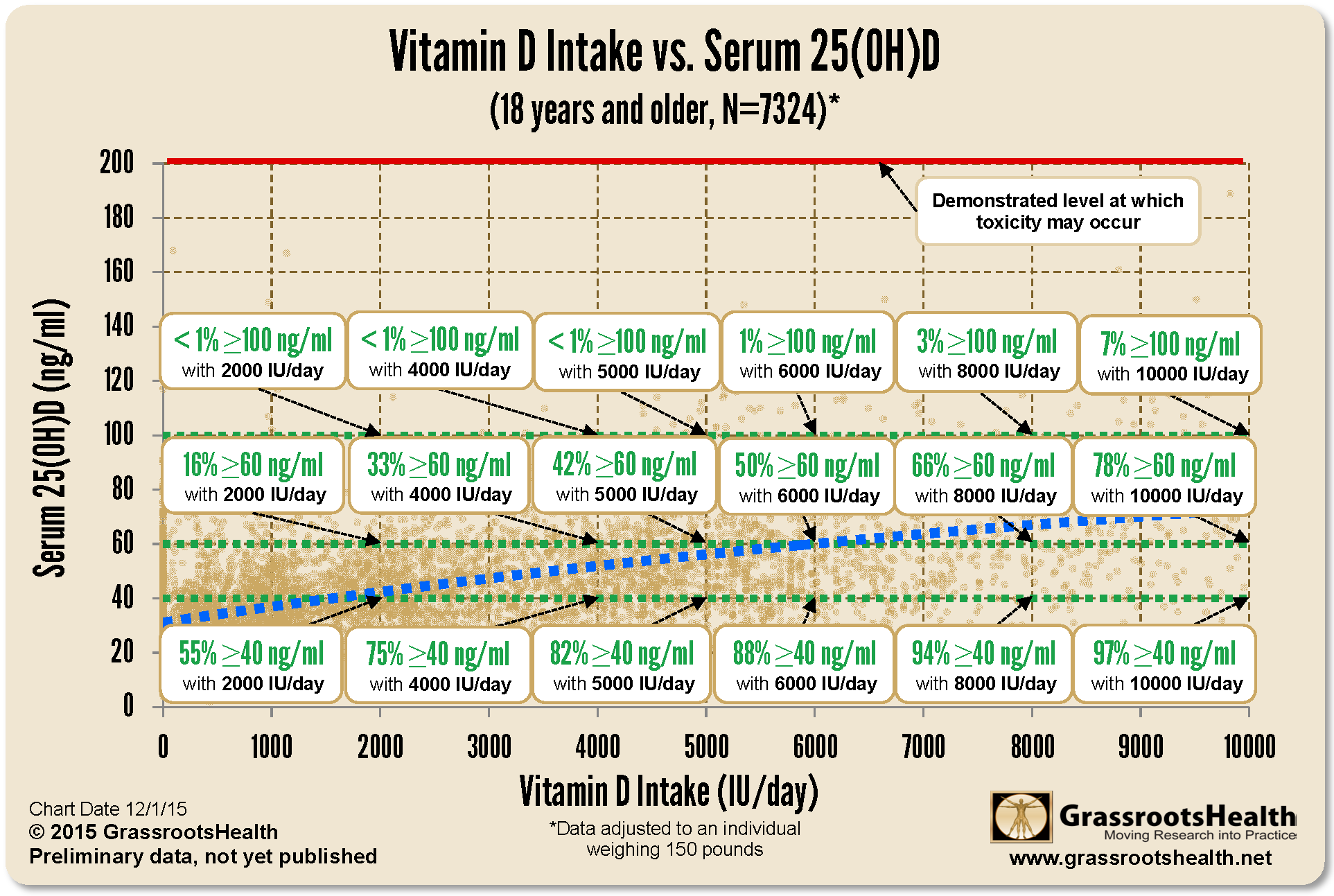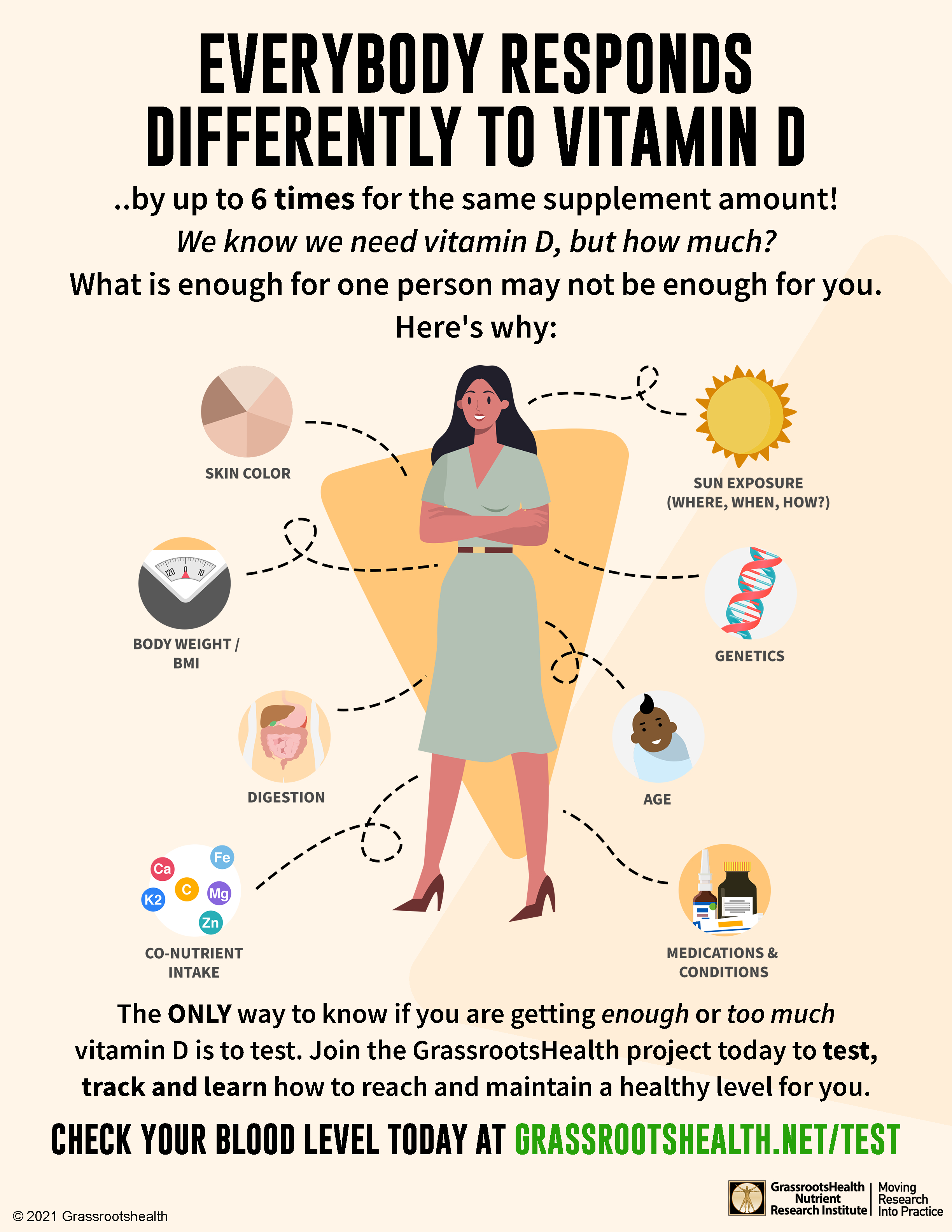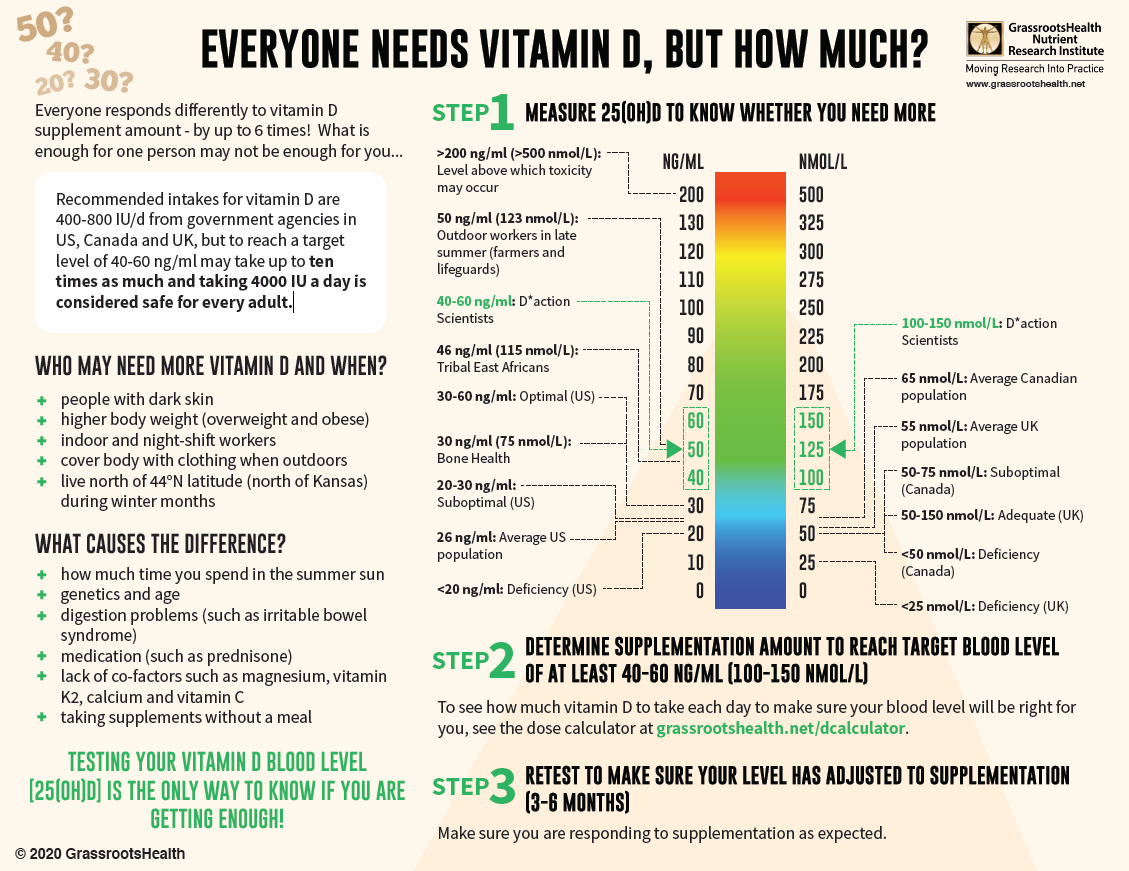Published on November 25, 2022
“My husband needs 10x more D than me…” One of the most important things to understand with vitamin D, and why measurement is so important, is the variability in individual dose-response
 It is not uncommon to hear general suggestions about how much vitamin D people need. Whether considering the extremely low recommended daily allowance (RDA) for vitamin D as set by the National Academy of Medicine (previously the IOM) or a general suggestion of intake, such as 4,000 IU per day, it is impossible to know how much might be “right” for one person to the next. In fact, the infographic below prompted the following response:
It is not uncommon to hear general suggestions about how much vitamin D people need. Whether considering the extremely low recommended daily allowance (RDA) for vitamin D as set by the National Academy of Medicine (previously the IOM) or a general suggestion of intake, such as 4,000 IU per day, it is impossible to know how much might be “right” for one person to the next. In fact, the infographic below prompted the following response:
“My husband and I were taking the same amount of D that kept me within the 40-60 ng/ml range. Same dose did not even put him at 20 ng/ml! He needs 10x more than me to reach 30-40 ng/nl. He is a Type 2 diabetic.”
Is this possible? YES! A GrassrootsHealth analysis showed that among all adult participants taking an average of 4,000 IU vitamin D per day from supplements, approximately 25% were still below the recommended 40-60 ng/ml.
Why You Can’t Assume Your Supplement is Enough
Everyone responds differently to vitamin D… by up to 6 times for the same supplement amount! Whether getting your vitamin D from sun or supplement, several factors can affect how much vitamin D is made, absorbed, or converted for use in the body. The infographic below summarizes some of these different factors that can affect how much vitamin D the body may actually be getting on a daily basis.
Click to Download, Share & Print
(Great message to share with anyone who is concerned about their health!)
Are you relying on supplements to get your vitamin D? If so, it is important to understand how certain factors can influence how an individual’s vitamin D level responds to their vitamin D supplementation amount (called the dose-response). These factors can cause a wide range of serum level responses that can be produced when looking at any specific supplementation amount. For example, it is possible for a supplemental intake of 4000 IU/day to result in a serum level of 25 ng/ml (62.5 nmol/L) in one individual, and 60 ng/ml (150 nmol/L) in another.
The following factors influence the variability in vitamin D dose-response for each individual:
Co-Nutrient Intake. A lack of key vitamin D co-nutrients can keep vitamin D levels from rising or inhibit its proper use. Examples of important co-nutrients include magnesium, vitamin K2, calcium, and others.
Digestion. Certain digestive conditions such as irritable bowel disease, Crohn’s disease, leaky gut, or celiac disease can limit the absorption of vitamin D in the gut. Those with diseases of the liver (e.g. fatty liver) or pancreas, who have had their gallbladder removed, or who have had bariatric surgery bypassing the small intestine are more likely to have trouble absorbing or metabolizing vitamin D. For these individuals, an increased dosage or other vitamin D metabolites may be needed (please consult with your physician if this is the case).
It is also important to take vitamin D with a fatty meal, as doing so can help increase absorption.
Body weight/BMI. Vitamin D, as a fat-soluble vitamin, has a higher affinity for the fatty tissues of the body. Therefore, those with a higher BMI will likely need to take a larger vitamin D supplement dose to achieve their target level.
Genetics. New research is showing that certain genetic variants can lead to decreased conversion of vitamin D within the body.
Medications and Conditions. A recent illness or injury may result in a lower vitamin D level. Digestive disorders, as mentioned above, can decrease absorption of vitamin D. Also, some drugs including statins, prednisone and weight-loss drugs can block vitamin D.
Age. With increased age comes a reduced ability to produce vitamin D in the skin in response to UVB exposure and a reduction in the kidney’s ability to convert vitamin D to its active form.
What Additional Factors Affect Vitamin D Levels?
Sun Exposure: Where, When, How. If you’re relying more heavily on sun exposure (or indoor UVB) for vitamin D, not exposing enough skin, high sunscreen use, or lack of mid-day (10 am – 2 pm) exposure will limit vitamin D production. Environmental factors such as smog and cloud cover or residing in a higher latitude will also reduce exposure to UVB radiation.
Skin Color. The amount of melanin in the skin influences vitamin D production. Someone with more melanin (darker skin) might need 30 minutes in the sun to achieve the same production of vitamin D that someone with less melanin (lighter skin) will achieve in 10 minutes. While some people can achieve very high levels (~60 ng/ml or 150 nmol/L) of vitamin D through regular sun exposure alone, others cannot achieve these levels without supplemental vitamin D.
What About Vitamin D from Food?
Certain foods that have naturally occurring vitamin D (e.g. fish, meat, and eggs) or are fortified with vitamin D (e.g. milk and other dairy products, some orange juice and cereals) can impact vitamin D levels. However, the amount of vitamin D available in food is rather small compared to what most people need to achieve a blood level of at least 40 ng/ml (e.g. salmon has ~450 IU/serving and fortified milk has ~120 IU/cup).
How do You Know What Dose is Good for YOU?
The only way to know is to test your level! Testing vitamin D levels versus blind supplementation is essential to know for sure if what you are taking is the right amount for you. Once you test your vitamin D level and know where you are NOW, you can account for any upcoming changes in lifestyle over the coming months and adjust your intake to reach (or maintain) your target.
GrassrootsHealth scientists recommend a vitamin D level between 40-60 ng/ml (100-150 nmol/L) as an optimal range, however, some individuals may choose to aim slightly higher for reasons such as cancer prevention. Once choosing a target level, individuals can use the vitamin D*calculator to help determine an estimated daily dose of vitamin D. It may take several rounds of testing, adjusting, and re-testing to find the dose that works best for you in keeping within your target range.
Are You Getting Enough Vitamin D for Your Health?
With almost 90% of the general population having vitamin D levels below the recommended 40-60 ng/ml (100-150 nmol/L), it is obvious that most people need more vitamin D. While most of us cannot achieve a vitamin D level of 40-60 ng/ml from sun alone, either due to our lifestyle, where we live, or other circumstances, we can certainly reach those levels with the right amount of supplementation.
Below is another guide for how much you might need, and who may need more. Your levels can be tested safely at home – order your home test kit today.
By joining the GrassrootsHealth projects, you are not only contributing valuable information to our study, but you are also gaining knowledge about how you could improve your own health through measuring and tracking your nutrient status, and educating yourself on how to improve it. Do you know what your status of vitamin D, omega-3s, and other essential nutrients is? Could your levels be improved? Test now to find out!









